Abstract
Content
- Preface
- 1. The relevance of creating eco-villages in the Donbass region
- 2. Analysis of Waste water treatment system implementation
- 3. Analysis of Waste water treatment technology
- 3.1 Grates with the mechanized cleaning
- 3.2 Sand trap with a circular movement of water
- 3.3 Radial settling tank
- 3.4 Adsorption units
- 3.5 Disinfecting unit
- 4. Nanomaterials and water purification: opportunities for improving and protecting water supplies
- Conclusion
- References
PREFACE
A high population and manufacturing concentration on a small area for a long time led to environmental contamination collapse. South-eastern region of Ukraine cruelly used for industrial purposes since the Hughes. Nobody thought about ecology Ukraine takes 110-th place of environmental pollution in 122-th developed countries [1].
1. THE RELEVANCE OF ECOVILLAGE IN DONBASS REGION CREATION
From years to year 1,7 billion of waste water goes to rivers and ponds. This is 1/3 of all over Ukraine waste water.
Modes all region’s rivers changed through the artificial reservoirs creation. There are 157 artificial reservoirs in the Donetsk region. One of them has a volume of 160 million m3, 15 - 427,8 million m3, others – 285,7 million m3 of water.
Water availability per inhabitant is180 m3. It is 5 times less than average in Ukraine. Domestic water consumption per person in the last 15 years has decreased from 135 m3 in 1990 year to 64 m3 in 2006 year.
The main water polluters are metallurgical and coking manufactories (The biggest plant are in the Mariupol, Yenakiyevo, Makeyevka, Avdeyevka and Donetsk). The second water polluters are the coal and power industry. A lot of contaminants flow to region’s reservoirs comprising wastewater. In this way 484 thousand tons of sulphates, 183,7 thousand tons of chlorides, 12,7 thousand tons of nitrates and 85thoutand tons of petroleum products were dropped into the rivers and ponds. A high salt content in river’s water is observed because of dropping more the 1 million tons of salt by mine discharges [2].
Eco-village can be a good alternative for living in the high contaminated region. There are 250 private homes in the 5 km2 which made from the eco-materials. In this eco-village will be able to accommodate about 500 people permanently and the same will come for seasonal holidays. Autonomous systems of water and heat supply development will allow to be in compliance with environmental safety standards.
Eco-village design in the Donetsk region is a complex task of technical facilities interaction to achieve the desired results.
The ecovillage territory - 5km2, population - 1,000 people., water consumption - 250 liters / day. One of the main tasks is to clean the water of the closed cycle of centralized water supply by natural granular sorbents. Local natural materials using is an important condition which ensure environmentally friendly and low cost water system of eco-village. Water treatment equipment for complex settlement needs to be structurally simple and reliable. Flowsheet includes grid strainer, filtering equipment, septic tanks, basic cleaning installation. The water after a line of centralized wastewater treatment purity will use it for domestic purposes. The direct using water for cooking or drinking requires additional cleaning. According to experts high purification whole water used in the eco-village is economically feasible.
Water needs to be cleaned before using household with granules which possess high absorption and recovery ability. All technical solutions for water treatment system should provide high performance for closed cycle of centralized water supply with a minimum natural resources using.
Biological substances and slurries obtained after purification can be used as agricultural fertilizer. This factor should be in focus at designing water treatment systems. Used sorbents, which cannot be recovered, must be disposed to produce heat or used as components of various building materials (with compliance of environmental legal).
2. ANALYSIS OF WASTE WATER TREATMENT SYSTEM IMPLEMENTATION
The main characteristics of wastewater are wastewater flow rate (l/s, m3/day., m3/shift, e.t.c.), concentration of pollutants (mg/l, g/m3), irregularity of wastewater. All of these characteristics are necessary for the design of drainage systems (waste water treatment system).
The quantity of pollutants which goes into the municipal sewerage per day is average constant from each person (in g) [3]:
Suspended solids - 65
BOD 5 of clarified liquid - 35
BOD 20 of clarified liquid - 40
Nitrogen ammonium salts, N - 8
Phosphates, P2O5 - 1,7
Chloride, Cl - 9
Domestic waste water (DW) without industrial waste is almost absent. Exceptions -some resort towns, but waste water comes from garages contain oil and other contaminants that are typical of industrial waste water.
Scientific evidence shows that the coarse material from the total mass of pollutants is approximately 35.4%, colloids - 14.3%, dissolved solids - 50.3%. wastewater contains are organic substances 53.7%, mineral substances - 46.3%. It is considered that in domestic wastewater organic materials accounted for 58%, and mineral - 42%.
According to environmental regulations, the parameters of the treated waste water discharged to the relief or discharged into a pond must complying the values given in Table 2.1 [3]
| Parameter | Pollution standards, g / (person·d). |
| BOD total | 75 |
| BOD 5 | 60 |
| Suspended solids | 65 |
| Nitrogen ammonium salts, N | 8 |
| Nitrites | not normalized |
| Nitrates | not normalized |
| Phosphate P2O5 | 3,3 |
| SAS | 2,5 |
Different methods using for wastewater treatment:
- mechanical,
- biological (or biochemical),
- chemical and physical-chemical,
- electrochemical,
- deep-cleaning (post-treatment after full biological treatment),
- thermal treatment,
- disinfection and sludge treatment [4].
Complex of waste water treatment system can be separate into several characteristic stages:
- - mechanical cleaning;
- - biological treatment;
- - post-treatment;
- - isinfection;
- - sludge treatment [5].
A lot of precipitates are forming as a result of insoluble substances losses in the primary waste water settling tanks. In addition, as a result of biological treatment produces a lot of sediment that is released in the secondary clarifiers. The precipitate consists of water diluted solids. For dewatering used different solutions - vacuum filtration, filter pressing, centrifugation. A lot of effective devices created for thermal drying and burning precipitation[6].
Treatment facilities are designed on two conditions: for maintain by residents (local treatment facilities ), or by serviced technician (township treatment facilities).
3. ANALYSIS OF WASTE WATER TREATMENT TECHNOLOGY
Cleaning method of waste water disposal facilities selecting (their type and largely) depends on a local conditions: the availability of area for treatment facilities installation, area remoteness of housing, topography, soil, water and climate conditions, the nature and location of the reservoir, which can be lowered purified.
The eco-village water management system should solve the problem of technological, technical and environmental issues. As one of the possible variants of the logical scheme, which display the essence of the system, is shown on Figure 3.1.
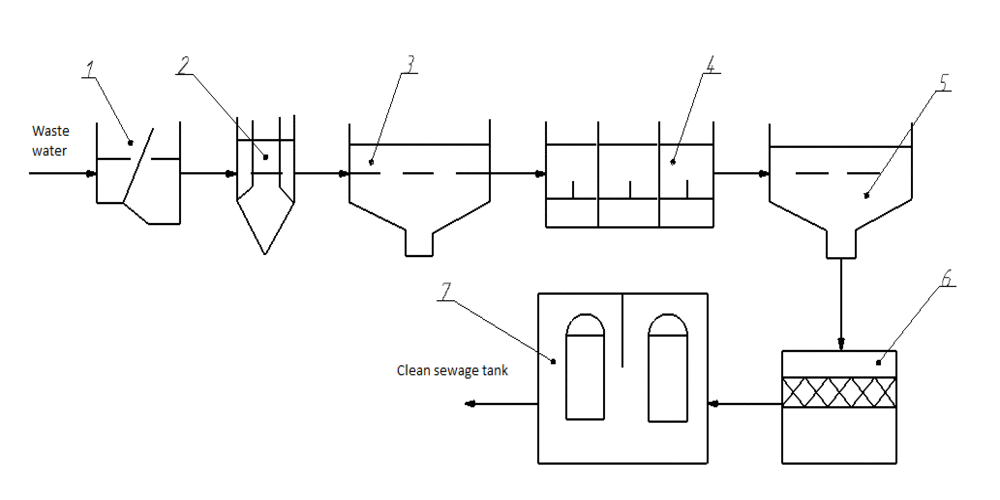
1 - grating with the mechanized cleaning;
2 - horizontal sand trap with a circular movement of water;
3 - primary radial settling tank;
4 - filter adsorption units;
5 - secondary radial settling tank;
6 - purification unit;
7 - disinfecting unit.
Figure 3.1 – Eco-village’s technological scheme of wastewater treatment in Donetsk region (made in mp_gif_animator, 150 kB, 10 frames, 0,4 s delay between frames, 7 cycling).
3.1 Grates with the mechanized cleaning
Mechanical screens installed on trays In order to restrain entering dirtiness (Figure 3.2). Then the detainees remains from screens periodically removed and dumped in containers with tightly fitting lids. Remains take out with garbage trucks in a specially designated area. After grating technical water flows to sand traps hydraulic elevator by means of installed pumps [7].
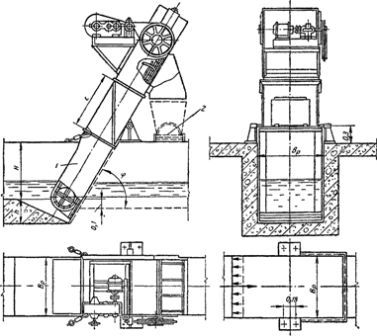
1 - mechanized grating with a rake;
2 - transporter
Figure 3.2 – Diagram of grid installation with mechanized cleaning
3.2 Sand trap with a circular movement of water
Sand traps are used in combination of mechanical waste water treatment and are intended for sand detention from residential, industrial and oil contained waste water. Sand traps are the round tank with a conical bottom (Figure 3.3). Inside the sand trap is an annular tray, which end the opening slit at the bottom
Removal of sand from the sand trap is carried out by hydraulic elevator. Horizontal sand trap with a circular movement of water was accept based on the typical design solutions for stations with capacity up to 7000 m3/day [7].
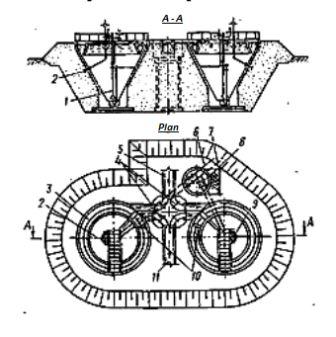
1 - hydraulic elevator;
2 - pipe to drain pop-up impurities;
3 - gutter;
4 - hand-operated valves;
5 - feed tray;
6 - slurry pipeline;
7 - the working fluid pipeline;
8 - camera for switches;
9 - device for collecting impurities from surface;
10 - semisubmersible shields (for cleaning oil-contaminated wastewater);
11 - discharge tray.
Figure 3.3 – Sand trap with a circular movement of water and capacity of 1400—6400 m3/day.
3.3 Radial settling tank
Primary settling tanks are used for pretreatment waste water before main treatment facilities. (Figure 3.4). Insoluble and suspended solids are filtered in primary settling tanks [7].
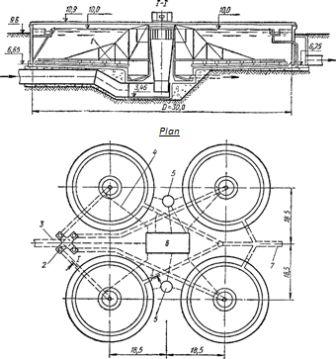
1 - scraper;
2 - distribution bowl;
3 - supply pipeline;
4 - piping of raw sludge;
5 - fat tank;
6 - pump station;
7 - outlet piping.
Figure 3.4 – Primary radial settling tank
3.4 Adsorption units
Adsorption water purification is carried out by the intensive mixing water with the filler for a certain time and sorbate subsequent sedimentation. (fig. 3.5) [8].
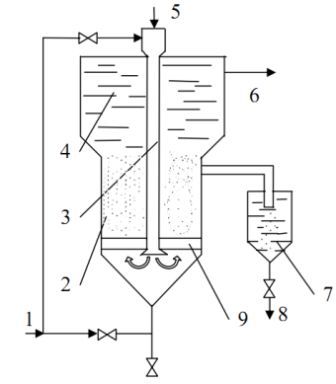
1 - water supply;
2 - cylindrical column;
3 - central tube with a diffuser;
4 - sheet steel drum;
5 - sorbent feeder;
6 - discharging treated wastewater;
7 - thickening of the sorbent;
8 - release of spent sorbent;
9 - distribution grid.
Figure 3.5 – The scheme of the adsorber
3.5 Disinfecting unit
Disinfecting system is a device for purification by the ultraviolet irradiation (Fig. 3.6). UV- Disinfecting is the final stage of purification which allows to give a proper water quality. Ultraviolet radiation has a bactericidal action. As a result of UV exposure is all pathogenic micro-organisms destruction. We can see instantaneous bactericidal effect when Continuous-wave ultraviolet radiation acts on water in the wavelength range 180-300 nm. Pre-treated in wastewater facilities water passes through the installation disinfecting unit which made of cylindrical body with quartz shrouds. When a fluid flows through them water is cleaned. Ultraviolet disinfection is the safest and most effective way for disinfecting [8].

Figure 3.6 – UV disinfection system
The main advantages are: the possibility of all microorganisms destruction (there is no need to add chemicals), preservation of physicochemical water properties (there is no risk of harmful compounds to the body). UV disinfection is economically expedient and practically decision for water treatment.
4. NANOMATERIALS AND WATER PURIFICATION: OPPORTUNITIES FOR IMPROVING AND PROTECTING WATER SUPPLIES
Recent advances suggest that many of the issues involving water quality could be resolved or greatly ameliorated using nanoparticles, nanofiltration or other products resulting from the development of nanotechnology. Innovations in the development of novel technologies to desalinate water are among the most exciting and promising. Utilization of specific nanoparticles either embedded in membranes or on other structural media that can effectively, inexpensively and rapidly render unusable water potable is being explored at a variety of institutions. In addition to obvious advantages for industrialized nations, the benefits for developing countries would also be enormous. Innovative use of nanoparticles for treatment of industrial waste-water is another potentially useful applic ation. Many factories generate large amounts of waste-water. Removal of contaminants and recycling of the purified water would provide significant reductions in cost, time, and labor to ind ustry and result in improved environmental stewardship. Aquifer and groundwater remediation are also critical issues, becoming more important as water supplies steadily decrease and demand continues to increase. Most of the remediati on technologies available today, while effective, very often are costly and timeconsuming, particularly pump-and-treat methods. The ability to remove toxic compounds from subsurface and other environments that are very difficult to access in situ, and doing so rapidly, efficiently and within reasonable costs is the ultimate goal [9].
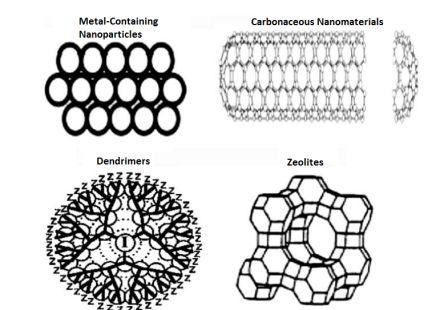
Figure 4.1 – Nanoscale materials for water puri?cation
Figure 4.1 highlights four classes of nanoscale materials that are being evaluated as functional materials for water purification: (1) metal-containing nanoparticles, (2) carbonaceous nanomaterials, (3) zeolites and (4) dendrimers. These have a broad range of physicochemical properties that make them particular attractive as separation and reactive media for water purification [9].
CONCLUSION
Technical solutions for water treatment systems must ensure minimal use of natural water resources in closed loop water recycling.
Biological substances and slurries obtained after purification can be used as agricultural fertilizer. This factor should be in focus at designing water treatment systems. Used sorbents, which cannot be recovered, must be disposed to produce heat or used as components of various building materials (with compliance of environmental legal)
REFERENCES
- Парфенюк А.С., Аверин Е.Г. Экологические проблемы индустриальных мегаполисов: Материалы международной научно-практической конференции. Донецк – Авдеевка. 21 – 23 мая 2008 г., - Донецк, ДонНТУ Минестерства образования и науки Украины, 2008. – 168с. Анализ состояния зеленых зон на территории города Донецка.
- Доклад о состоянии окружающей среды в Донецкой области под редакцией С. Третьякова, Г. Аверина, Донецк, 2007. – 116 с.
- СНиП 2.04.02-84 Водоснабжение. Наружные сети и сооружения. – М., 1985.
- Розенталь Е.Д. Анализ эффективности инвестиций в восстановление водных ресурсов//Водные ресурсы. Вода, Промышленность, Водные ресурсы, Восстановление, Эффективность. 1989.
- Беспамятнов Г.П., Предельно допустимые концентрации химических веществ в окружающей среде / Рихтер К.К.//Химия 1987.
- Ola Jonassen VVS Norplan AS, Norway, Angelique Leonard, Michel Crine Université de Liège, Belgium, Stig Stenström Lund University, Sweden/Annex X, Energy Efficient Drying and Dewatering Technologies, Technical report 1, Drying and dewatering of sludge – Summary of papers, presented at ECSM´08
- Сомов М.А. Водопроводные системы и сооружения: Учеб. для вузов.-М.:Сторйиздат, 1988 – 399. с.:ил.
- Яковлев С.В., Карелин Я.А., Лесков Ю.И.,Воронов Ю.В. Очистка производственных сточных вод : Учеб. пособие для ВУЗов/ Под ред. Яковлева С. В.-2ое изд., перераб. и доп. – М.:Стройиздат, 1985-335 с., ил.
- Journal of Nanoparticle Research (2005) 7: 331–342, Springer 2005, DOI 10.1007/s11051-005-7523-5 Perspectives, Nanomaterials and water purification: Opportunities and challenges. Received 9 March 2005; accepted in revised form 17 May 2005.
